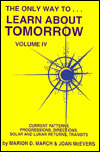Continued from Part I
Interpreting Fertility Charts
The rules are basically very simple. In its own way, this is a type of electional chart, and since we are dealing with conception, everything is based on the Moon. If you are not familiar with electional rules, check The Only Way to ...Learn about Horary and Electional Astrology, or any other electional astrology book you can find. As in most electional charts, avoid lunar squares and definitely shun squares from the Moon to Mars, to Saturn, or to Uranus. I also try to stay away from the Moon opposing Saturn (delays, separations, maybe health complications) or Uranus (unexpected or sudden events).
Primarily, check all the applying aspects the Moon makes until it leaves the sign it is in. (Don't use any orbs.) If the Moon is 7? Leo, count every aspect it makes until it gets to 29°59' Leo. Next, look at the aspects the Moon makes to the natal chart, although this is less important. (Here, of course, you can use the so-called "normal" orbs.) If the fertility Moon is 7° Leo and the natal Mars is 10° Aries, it makes a trine. With the Moon at 7° Leo and Mercury at 4° Scorpio, it's a square.
Squares are challenges you wish to avoid for your client, but obviously a square to Venus or Mercury will not be as hard to handle as one to Mars. As always, your astrological interpretation and judgment will be as good as your knowledge and experience. Oppositions often just mean delays, which can be handled, except oppositions to Saturn and Uranus, as stated earlier. Mars should also be studied carefully. Quincunxes, so important in natal interpretations, seem to play a rather minor role in electional and fertility work.
Also, realize that electional charts cannot and should not be interpreted as if they were natal horoscopes. There are no humanitarian or psychological options. This is a moment in time chosen for a specific action -- in this case, to conceive a child. So use all the old-time rules. Saturn and Mars are "bad," while Jupiter and Venus are "good." Uranus, with its unexpected behavior, is not what you wish for in a pregnancy.
Void-of-Course MoonAnother rather significant electional rule concerns the void-of-course Moon. The usual wisdom is that nothing will happen, and therefore pregnancy does not occur. I'm still checking these phenomena for accuracy. I usually tell the client to try, since nothing bad should happen. So far, I have had only one pregnancy that occurred during a void-of-course Moon, and, of course, we'll never know if the semen reached the egg so late that the Moon had entered the next sign.
Pluto and ConceptionI have another question that, as yet, hasn't been answered to my satisfaction: What about Pluto? It stands for procreation, but, in the fertility chart, is it beneficial or not? I definitely avoid it when squaring the Moon. So far, it has not shown itself to be a problem when in opposition, but I have had a case of triplets with a Moon-Pluto conjunction and a very long (two weeks late) pregnancy with another conjunction.
The Ascendant and FertilityMany questions also arise regarding the Ascendant. (The MC is less important with fertility charts.) The Ascendant is faster than the Moon, since it advances 1° every four minutes, while the Moon needs two hours to advance 1°. Therefore the Ascendant should apply to the Moon and all the other planets, whereas most astrologers do the reverse. I have tried both ways and have found that I rarely use either. Only in very difficult situations, when there are only a few good days in a year, will I use the Ascendant. But please realize that even perfect fertility moments may not result in pregnancy. What looked perfect may come up empty and what looked less good may result in a lovely baby.
Fertility Challenge: Moon Squares in Natal ChartsCertain facts will become very obvious with experience, and certain natal charts can be harder to work with. A natal chart with Moon square Sun may be problematic. Therefore you need good aspects to the Moon after the square takes place. Let's say Client X has her Moon at 23°29' Aries and her Sun is at 23°58' Capricorn. Thirteen times a year this square gets repeated, but not with the Moon in Aries and the Sun in Capricorn. In the first Fertility Chart, let's say the Moon is 25°34' Scorpio, while the Sun is 26°03 Leo. The Moon will go void-of-course after squaring the Sun: not very good. In Fertility Chart #2, the Moon is 24°17' Sagittarius, while the Sun is 24°46' Virgo. After this square, the Moon squares Saturn at 29°30' Virgo: even less good. Then in the third Fertility Chart, the Moon is 23°24' Capricorn, and the Sun is 23°53' Libra. Before the Moon leaves Capricorn, it will sextile Uranus at 23°56' Scorpio and trine Jupiter at 27°55' Virgo. Eureka! This is what we look and hope for. In fact, this is an actual client who had only two "good" fertility charts that year and luckily did get pregnant on that day.
As I do with every client, I also counsel that she follow her natural ovulation with a temperature chart, or however her doctor suggests, and that she and her mate take advantage of that day as well. In fact, make sure that you NEVER contradict the doctors. Your client needs to trust them, and so should you, especially if you are working with some of the new fertility procedures. Once I have studied the thirteen charts, I discuss all of them with the client, including some possible problems. We also talk about the fact that some men have problems performing on command at a set time. Sometimes I advise that the woman not share the time schedule with her partner. If both are involved, I often suggest that they have a party or somehow celebrate the event, anything to avoid stiffness or embarrassment.
Baby's Natal ChartPlease remember that the fertility charts are just what the name implies they have nothing to do with the possible time or manner of the baby's birth, nor do they even remotely resemble the natal chart of the baby. The 100-plus charts of actual conception moments versus the baby's natal chart have none of the magic similes expected or wished for by old-time astrologers. Even the actual moment of merging of semen and egg, as done in vitro, does not yield great resemblance between that horoscope and the baby's.
Once the client becomes pregnant, then that chart becomes the pregnancy chart. Even then it has nothing to do with the baby's birth. But it rather accurately describes the pregnancy itself, including some possibly difficult areas. At that time, the interpretation is like any other event delineation. Since the Ascendant describes the client and her physical body, the Ascendant ruler assumes quite a bit of importance, and its aspects become meaningful as the pregnancy develops.
Predetermining Baby's Gender with AstrologyAs to predetermining the baby's gender -- the answer is maybe, but should be no. A male Moon (Aries, Gemini, Leo, Libra, Sagittarius, Aquarius) should produce a boy; a female Moon should result in a girl. But, we never quite know how long it takes the semen to reach the egg. Consequently, you should not promise the client anything! Remember, it can take the semen more than 60 (as much as 72) hours to fertilize an egg; in that time-span the Moon may have entered the next sign.
Approximately 7 million Americans of varying socio-economic profiles suffer from infertility, meaning they have been unable to conceive a child after one year of unprotected and regular intercourse. Of those, 50 percent can get pregnant by procedures that are neither invasive nor exotic, such as the astrological fertility cycle, or, if under a doctor's care, by finding their own ovulation periods, and by limiting or eliminating use of alcohol, medications, drugs, and cigarettes. The other, more serious, problems tend to be low sperm counts, tubal blockages, infrequent ovulation, hostility of cervical chemistry to sperm, and, of course, the age of the mother-to-be.
Fertility drugs have been around for quite awhile, but there are many new and diverse approaches, and I have found that we, as astrologers, can be of much help. Here are the most commonly used methodologies with their 1996 average cost.
-
* Artificial Insemination -- inseminating the woman with her partner's "washed" sperm. (Between $1,000 and $4,000.)
-
* In Vitro Fertilization -- The woman's egg is removed from a ripe follicle, fertilized in a dish in the laboratory, allowed to divide, and reinserted into the woman's uterus. (Mostly between $6,000 and $10,000.)
-
* GIFT and ZIFT (Gamete and Zygote Intrafallopian Transfer) -- In GIFT, the egg is removed, immediately mixed with the washed sperm, and reinserted into the woman's fallopian tubes in hopes that fertilization will occur. In ZIFT, a fertilized embryo is returned to the tube. (Add another $1,000 or so to the in vitro cost.)
There are many variations within these procedures -- intrauterine insemination or intra-tubal insemination; opening the egg's outer shell to give the spermeasier access, known as partial zonal dissection, followed by subzonal insertion (aka SUZI); and the Belgian procedure in which a single sperm is propelled to the egg's center, also known as ICSI (intracytoplasmic sperm injection).
In most of the cases, the doctor gives the patient a "window" of 12-to-36 hours as to when the procedure should be done. That is the only time span we, the astrologers, have to work with. At this point we can do an electional chart to help the client find the best time available within the 12-to-36 hours. Fertility has become such a specialized field that all kinds of clinics have sprung up, many of them open at all times of the day and night.
Please realize that this is only a beginning, and it will be up to you to continue researching the subject. But so far I have found that the closer insemination is to the astrological fertility date, the better are the results.
Quite a few times I was able to convince my client to skip a few months, noting that her natural ovulation was moving toward the astrological peak day. This can happen rather frequently, since many women do not ovulate the every 29-1/2 days that the fertility cycle takes.
Timing the Implantation of the Fertilized Egg
Another intriguing bit of learning came with the realization that it doesn't seem to matter when the eggs are taken from the ovaries, or when the husband's sperm is added. It does not even matter when the eggs become fertile. The moment that checks out time and again is when the fertilized egg is implanted. The same goes for artificial insemination. It doesn't matter when the semen is given, only when it gets implanted.
Again, the Moon is the most important factor to consider. Try to get your client to enter the clinic, or whatever facility the doctor is using, after any difficult aspects to Saturn or Uranus, particularly the squares. If possible, I like to avoid a conjunction, opposition, or quincunx to certain planets when dealing with clinical procedures. I don't like challenging lunar aspects to Mars (cutting), but I have had both positive and negative results with aspects from the Moon to Pluto. Again, Pluto is definitely one planet that needs a lot more research than my few cases can offer. Also, Moon-to-Neptune squares can result in allergies or strange reactions to drugs, but not always.
These are just a few ideas to get you started on the interesting journey of the future, because I think the 21st century may bring us many more problems with the process of childbearing. If you need real life examples, you can find some in Volume 6 of The Only Way to ... Learn Astrology series, or some workshops or classes that have been taped.
DISCLAIMER: All information provided herein is based upon original research methods used by Marion D. March. It is written with reliable intent. The purpose is to inform, educate, and make available tools for individual research. It is not intended to mislead. Although these methods have worked reliably in the past, not enough actual cases have been handled. There is, therefore, no guarantee whatsoever that they will work in the future. Neither the author, publisher, nor programmers connected with this article assume any responsibility for any user's activities or recommendations.
@ 1997 Marion D. March - all rights reserved. This article was originally published in the Oct./Nov. 1997 issue of The Mountain Astrologer, www.MountainAstrologer.com.
Book by this author:

"The Only Way to Learn About Tomorow"
by Marion D. March, et al.
Info/Order this book
 About The Author
About The Author
Marion D. March has been a professional astrologer since 1972. With Joan McEvers she co-authored the six-volume best-selling hook series The Only Way to...Learn Astrology (translated into eight languages), and cofounded Aquarius Workshops and ASPECTS magazine. Marion lectures worldwide, has received the prestigious Regulus and Robert C. Jansky awards, helped form and promote ARC, and has appeared on numerous radio and TV shows. She may he contacted via e-mail at
























